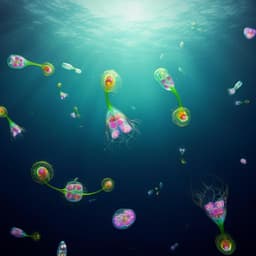
Earth Sciences
Decoding drivers of carbon flux attenuation in the oceanic biological pump
M. Bressac, E. C. Laurenceau-cornec, et al.
This study by M. Bressac and colleagues reveals the dynamics of the biological pump and the role of microbial processes in oceanic carbon flow. Using in situ experiments from C-RESPIRE, the research uncovers how microbial degradation impacts particle flux attenuation across diverse oceanic environments.
~3 min • Beginner • English
Introduction
The biological carbon pump annually supplies 5–10 Gt of carbon to the oceans' interior, driving long-term sequestration and providing energy for deep-sea ecosystems. The pump efficiency is set initially by myriad transformations of newly formed particles in the euphotic zone, followed by pronounced vertical flux attenuation via mesopelagic processes that ultimately influence atmospheric CO₂ concentrations. The vertical particulate organic carbon (POC) flux attenuation is typically measured by multiple-depth radionuclide sampling, sediment-trap deployments and/or optical particle measurements and is often expressed as a power-law exponent (b value). The b value is widely used to intercompare and understand attenuation patterns across different provinces and to explore roles of oxygen, temperature, primary productivity or floristics in setting global patterns. Despite decades of research, there is no consensus on the controls of POC flux attenuation; opposing latitudinal trends in b values have emerged from global syntheses, observations and model analyses. Such disagreement is unsurprising as POC flux attenuation is the cumulative signature of distinct transformations from zooplankton flux-feeding to particle-attached microbial degradation. A better understanding therefore requires separating the processes that jointly set POC flux attenuation to provide insights—directly for microbes and indirectly for zooplankton—into their relative magnitudes, vertical trends, controls and influence on regional patterns. Particle degradation by attached bacteria and other microbes is pivotal in POC flux attenuation through colonization and transformation of sinking particles. Here microbial remineralization (MR) is defined as the microbially mediated component of POC flux attenuation. The study presents mesopelagic MR of sinking microbially colonized particles from in situ C-RESPIRE experiments to explore controls on MR magnitude with depth and across regions, and its percentage contribution to flux attenuation in the upper mesopelagic (~100–300 m), where POC flux is highly attenuated.
Literature Review
Prior work commonly parameterizes POC flux attenuation using the Martin curve and compares its exponent (b) across regions. Global syntheses and models have produced opposing latitudinal trends in b, reflecting the complexity of processes governing attenuation. Factors such as oxygen, temperature, primary productivity and community composition have been implicated in setting attenuation patterns, yet consensus is lacking. Sediment traps and radionuclide methods quantify cumulative attenuation but provide limited insight into the relative roles of microbial remineralization versus zooplankton-mediated processes (flux-feeding and diel vertical migration). Laboratory and in situ studies have explored particle-associated microbial respiration, but often by subsampling or isolating particles, introducing uncertainties. Temperature has been proposed as a dominant global driver from palaeo and contemporary perspectives; however, evidence suggests that temperature effects vary regionally and may be confounded by particle composition, microbial community structure, and zooplankton fragmentation. Shifts in respiratory quotient (RQ) from unmodified phytoplankton cells (RQ ~0.89) to marine snow (~0.70) and more heavily modified particles (~0.50) suggest depth-dependent changes in substrate quality that could alter microbial physiology and carbon-use efficiency, analogous to findings in soil microbiology.
Methodology
- Instrumentation and approach: The study used C-RESPIRE, a dual particle interceptor and in situ incubator. Unlike conventional sediment traps that instantly preserve intercepted material, C-RESPIRE intercepts settling particles after they have experienced overlying-water transformations (zooplankton flux-feeding, diel vertical migration and microbial activity) and then incubates them in situ for multiple days to isolate microbial remineralization (MR).
- Measurements: During incubation, oxygen consumption was measured with optodes and converted to carbon units using a fixed mesopelagic respiratory quotient (RQ) of 0.70 representative of plankton-based particles (sensitivity analyses used bounds 0.50–0.89). Dissolved organic carbon accumulation during incubation was also measured and was low on average (21 ± 16% of MR), indicating close coupling between solubilization and respiration.
- Flux partitioning: Two flux components were quantified: (1) MR, the microbially mediated attenuation during incubation; and (2) residual POC flux, the POC remaining after incubation, representing material inaccessible to microbes during the incubation. The cumulative POC flux at each depth was reconstructed as residual POC flux + MR, analogous to what sediment traps would measure. Power-law fits (Martin curves) were applied to cumulative flux profiles at sites with sufficient depths.
- Study regions and depths: Deployments were conducted across six contrasting provinces spanning a broad productivity gradient: South Georgia (SG), Benguela (BEN), Subantarctic Zone (SAZ), northeast subarctic Pacific (PAPA), Mediterranean (MED), and South Pacific Subtropical Gyre (SPSG). Incubations targeted the upper mesopelagic (~100–300 m); incubation durations varied up to threefold among sites due to logistics. At MED and SPSG, only two depths below the primary production zone (PPZ) were sampled.
- Assumptions and controls: Analyses assumed approximately constant sinking velocities over the ~200 m depth range sampled. C-RESPIRE rapidly isolated particles from zooplankton-mediated processes upon interception (zooplankton excluded by design) to attribute subsequent changes solely to MR. Uncertainty propagation methods were used to derive error bars, and sensitivity to RQ choice was evaluated.
- Normalized rate metric: MR was normalized to incubation time and cumulative POC flux to derive a carbon-specific remineralization rate, C_remin (d⁻1), enabling comparison of MR influence with depth and temperature across sites.
Key Findings
- MR contribution to attenuation: Across six oceanic regimes spanning a 30-fold range in POC flux, particle-attached microbial degradation comprised a median 7–29% of cumulative POC flux attenuation in the upper mesopelagic and never exceeded 35% even across RQ bounds (0.50–0.89). Residual (non-microbial) processes dominated cumulative attenuation (80 ± 13%).
- Cumulative flux patterns: Over ~200 m, reconstructed cumulative POC flux followed a Martin-type power-law decline at 5 of 6 sites (SAZ showed increasing flux with depth, attributed to a composite water column). Reconstructed cumulative fluxes were comparable to sediment-trap observations, supporting the method.
- MR vertical structure: MR magnitude varied little with depth within sites, yet differed four-fold among provinces, indicating regional differences in particle composition and plankton assemblages.
- C_remin variability: C_remin spanned 0.02–0.43 d⁻1 across sites and depths (median by site: 0.08 d⁻1 at SG to 0.23 d⁻1 at SPSG), a 20-fold range, demonstrating sufficient carbon supply to meet particle-attached microbial demand in the upper mesopelagic.
- Depth and temperature effects: At SG, SAZ, PAPA and MED, C_remin increased with depth, consistent with roughly constant MR and decreasing cumulative flux. At BEN and SPSG, C_remin decreased with depth where vertical temperature gradients were large; depth relationships had R² ≈ 0.29 (BEN) and 0.43 (SPSG), while temperature relationships were stronger with R² ≈ 0.80 (BEN) and 0.39 (SPSG).
- DOC during incubation: Dissolved organic carbon accumulation during incubations averaged 21 ± 16% of MR, supporting close coupling of solubilization and respiration.
- Implicated drivers: Temperature emerged as a key control on C_remin at low-latitude sites with >2 °C mesopelagic gradients, while at mid/high latitudes (gradients <2 °C) depth trends likely reflect joint effects of particle biochemistry (lability, changing RQ), microbial community composition/physiology, and zooplankton-driven fragmentation enhancing microbial access.
Discussion
By isolating microbial remineralization from zooplankton-mediated processes, the study deconstructs the Martin curve to reveal underlying mechanisms. Findings show that microbes play a consistent yet secondary role in upper-mesopelagic POC flux attenuation relative to zooplankton flux-feeding and diel vertical migration, which likely shape the power-law decline of residual and cumulative fluxes through epipelagic modulation of particles. Because MR profiles are relatively flat with depth while cumulative flux declines, the relative importance of MR is expected to increase with depth. Temperature is not a universal driver of microbially mediated attenuation: it exerts strong control only at low-latitude sites with pronounced mesopelagic gradients. At mid- and high-latitude sites with small temperature gradients, depth-dependent increases in C_remin are better explained by changes in substrate quality (evolving particle biochemistry, reflected in RQ changes from ~0.89 to ~0.50 with particle transformation), microbial community structure and function (including exoenzyme adaptations and variable carbon-use efficiency), and zooplankton/physical fragmentation that increases surface area for microbial colonization. These mechanistic insights reconcile disparate regional patterns in attenuation metrics and argue for models that explicitly separate microbial and zooplankton pathways. Given that two-thirds of the ocean exhibit small mesopelagic temperature gradients and future projections suggest these patterns will persist, non-temperature drivers will remain critical for setting POC flux attenuation across much of the ocean.
Conclusion
Concurrent measurements of intercepted POC supply and microbial respiration demonstrate ample carbon availability for particle-attached microbes in the upper mesopelagic. Microbial remineralization contributes less than 30% to cumulative POC flux attenuation across diverse regimes, indicating a lesser but influential role compared to zooplankton-mediated processes that largely shape Martin-type declines. Temperature modulates C_remin primarily at low-latitude sites with strong vertical gradients; elsewhere, multiple controls—particle biochemistry, microbial community composition and physiology, and zooplankton-driven fragmentation—govern depth trends. These results call for more nuanced biogeochemical models that partition attenuation between microbes and zooplankton and incorporate region-specific controls rather than a single global temperature relationship. Future work should integrate microbial ecology (e.g., carbon-use efficiency concepts), particle biochemistry and controlled particle experiments to refine parameterizations and improve projections of the biological carbon pump under change.
Limitations
- RQ assumption and sensitivity: MR conversion from O₂ to C used a fixed RQ of 0.70; although sensitivity bounds (0.50–0.89) were explored and did not change qualitative conclusions, true in situ RQ may vary with particle state and depth.
- Particle interception and sinking: C-RESPIRE halts particle sinking during multi-day incubations; despite arguments that MR magnitudes changed little with depth and represent upper mesopelagic conditions, stopping natural sinking could alter particle–microbe interactions relative to free-sinking particles.
- Zooplankton exclusion: Zooplankton were excluded by design; inferred roles of zooplankton (flux-feeding, DVM) are indirect, based on residual flux patterns rather than direct measurements of zooplankton activity.
- Assumed constant sinking velocity: Analyses assumed approximately constant sinking speeds over ~200 m; deviations could affect comparisons of MR versus residual flux with depth.
- Incubation duration variability: Incubation times varied by up to threefold among sites, potentially influencing MR estimates despite uncertainty propagation.
- Depth coverage and site number: Only six regions were sampled in the upper mesopelagic (~100–300 m); at MED and SPSG only two depths below the PPZ were available, limiting power-law fitting and depth-trend resolution.
- Temperature–physiology data gap: No direct thermal performance curves exist for mesopelagic particle-attached microbes under in situ conditions; mechanistic temperature interpretations rely on analogies.
- Multivariate confounding: Regional differences in PPZ depth, particle composition (e.g., biogenic vs lithogenic), seasonality and community composition precluded robust global statistical attribution beyond observed patterns.
Related Publications
Explore these studies to deepen your understanding of the subject.







